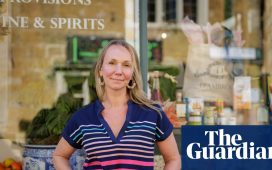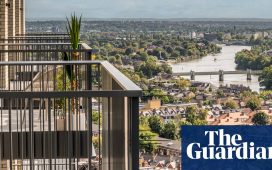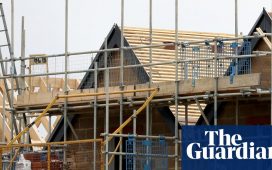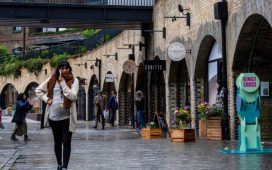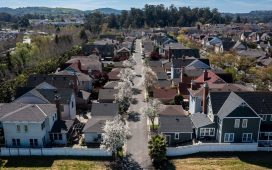Twice a day for the past 12 years, Markus Roggen, an artist and fashion consultant, has walked past the house at the end of his road and wondered to himself: “Why is it still empty?” Roggen’s road is no ordinary road, and the house on the corner is no ordinary house. It is a 45-room “private palace” with 116 windows, 68 of which have views over Hyde Park, in the most exclusive and pricey corner of central London. Welcome to 2-8A Rutland Gate, officially Britain’s most expensive house, and a property that lies completely empty.
Every day, thousands of people pass the building, which stands on the busy Kensington Road near a stop for the number 9, 23 and 52 buses, but most of them probably don’t give it a second glance.
Like many neighbours, though, Roggen, 48, is obsessed with it. He lives in a top-floor, two-bedroom flat owned by his “much richer boyfriend”, 100 metres up the street. “It is the talk of the neighbourhood,” says Roggen, who is tall, thin and dressed all in black, with a mop of artfully messy dark hair. “On both my morning and evening walks I pass it, and I want to know more and more about it.”
Roggen, who grew up on a farm in Bavaria and feels “blessed” to live in the centre of London, has tried peering through the windows, but that provided few clues. “It is totally vacant, there’s nothing in it at all – not even doors,” he says. “There has only ever been one light on, in one small room in the basement.”
Photos of the interior, published by developers, show a hollow shell, with crumbling internal walls, missing floorboards and half-ripped-out bathrooms. “I try to imagine who would live there, but it is just so big, I can’t,” Roggen says. “There’s a dark energy about the house. I wouldn’t live there even if I could afford it.”
He definitely can’t afford it. Few people on the planet could, given that it has been quietly put up for sale for £200m. The last time it changed hands, on 7 May 2020, it fetched even more than that, with Land Registry filings showing a sale price of £210m. It had been on the market for almost a decade, since its previous owner, the Saudi Arabian crown prince Sultan bin Abdulaziz, died in 2011. He had been given the house by the estate of Rafik Hariri, a billionaire businessman and prime minister of Lebanon, who was assassinated in a suicide truck bombing in Beirut in 2005.
Despite spending £210m on it, the new buyer never moved in. This is often the case with some of the world’s most expensive homes, which are bought as trophy assets or investment properties. But, in an unusual move given that most uber-rich people guard their privacy as fiercely as their fortunes, the estate agent did announce the buyer’s identity.
Beauchamp Estates, which promotes itself as selling London and the south-east’s most expensive houses to the world’s richest people, emailed journalists announcing that “2-8a Rutland Gate is in the process of being acquired by funds advised by the Family Office of Mr Cheung Chung-kiu”. Chung-kiu, better known as CK, is a Hong Kong-based billionaire who owns a string of property companies, including CC Land Holdings. He owns part of the former Whiteleys department store in Bayswater and 122 Leadenhall, the triangular-shaped skyscraper in the City of London better known as the Cheesegrater and worth more than £1bn. However, CK was never the ultimate owner of 2-8A Rutland Gate. He appeared to be, according to Land Registry filings, just a frontman – but more of that later. For now, what Roggen and his neighbours want to know is who might buy the house next, and what might they do with it.
Whoever does buy the Rutland Gate mansion is likely to immediately start demolishing it. The house is being sold with planning permission to be partially knocked down and rebuilt, bigger and bolder. The two‑storey basement is to be dug even deeper to install a larger swimming pool, a health spa and underground parking for the new owner’s inevitable collection of luxury cars. The house itself will be reconfigured to include a triple-height ballroom, and the living space extended to a total of 5,760 sq m (62,000 sq ft). That’s the equivalent of just over 29 tennis courts.
Plans for the “mega mansion” were voted through despite the local council’s ban on new “Monopoly board-style” residences, intended to free up space for more affordable homes. Westminster city council imposed no commitments on the developer to build or contribute to the construction of any affordable homes in the borough. The council says the house was exempt from the rules requiring residential projects to include at least 30% affordable housing as it is not considered a “new” development, and because it was previously a single residence it is not caught by the mega-mansion ban. So the development will go ahead despite more than 4,000 families sitting on the borough’s affordable housing list, many of whom have been waiting more than a decade for safe housing.
The current building is, in the words of architects, urban planners and historians, “unremarkable”, “bland” and “ugly”. While it is now a single home, it was designed to mimic a row of five townhouses that stood on the same spot a century earlier, but with just one central door.
The owners hired Kevin Murphy, a former English Heritage historic building inspector, to investigate the “historical merit” of Rutland Gate in support of the rebuilding plan. Murphy’s report said the house was of little architectural or historical importance, but added: “The story of 2-8 Rutland Gate illustrates a good deal about how London evolved from the late 18th century to the present day, about the transformation of the original landed estates, about the social change and lifestyles in that period.”
The history of the house – and this neighbourhood – is a microcosm for the story of the rich in Britain. Since the first bricks were laid here in 1753, it has been a place for the richest of the rich, living lives divorced from the majority.
It’s been the home of landed gentry, then those who made their fortune from Britain’s colonies, including an advocate-general at the East India Company, and, more recently, the wealthy of the world who have overtaken Britons in the international league tables.
Many extremely rich people live in this corner of London, where the average weekly income (for those who actually work for a living) is £805 compared with the UK average of £630. The wealthy have lived in Knightsbridge since it was created from marshland in the early 1700s, according to Lucy Inglis, a historian who specialises in the history of London from the Georgians to today.
“Before then, this would have been open fields, a vast space between London and outlying villages,” she says. “People would have had to cross these fields to reach places like Chelsea from the city.” The Survey of London, a hugely ambitious academic endeavour to list every historic building in the capital, describes 18th-century Knightsbridge as a “sort of no man’s land” between the country villages of “Chelsey”, “Kensing town” and “Charing”.
People travelling to the villages had to cross a stone bridge over the Westbourne River, which was later dammed to create the Serpentine Lake in Hyde Park. The bridge, which had for decades been a target of highwaymen, is reputed to have been named after the knights who finally tackled the problem. With the robbers gone, the landed gentry – rich landowners who lived extravagant lives on rent collected from tenant farmers – began buying up land in Knightsbridge, where they built smaller versions of their country mansions.

In 1753 John Manners, the third Duke of Rutland and one of the richest people in the country, bought the leasehold to three fields to the south of Hyde Park and ordered the construction of his London home, Rutland House. It cost £4,432, according to the Survey of London, including paying a night watchman “£15 for meat for his cat” to guard the property for 440 nights during its construction.
Manners’ other home was a castle in the family’s ancestral seat between Nottingham and Peterborough. They had owned the vast Belvoir Castle estate (pronounced “beaver”) since 1067, when it was gifted to Manners’ first recorded ancestor, Robert de Todeni, by William the Conqueror. But Manners had tired of life at Belvoir and wanted to spend more time in the capital. He oversaw the construction of Rutland House in Palladian style with red bricks and Portland stone.
The mansion stood for just 83 years. Following the death of Manners’ son, it was put on the market to help cover death duties, but failed to attract a buyer. “Empty and unwanted, the neglected mansion survived until January 1836 when it was pulled down for redevelopment,” the Survey of London states. In contrast, Belvoir Castle still stands today and is home to the 11th Duke of Rutland. David Manners, 63, a hereditary peer who has been a high-profile Ukip supporter and hosted fundraising events at the castle, has admitted to not quite knowing how big his house is. “My father said there are 200-and-something-odd rooms,” he told Tatler. “I don’t really know how many there are. It depends if you count the small rooms in the towers.”
The land on which Rutland House had stood was earmarked for development. “This was the beginning of a property boom in Knightsbridge,” Inglis says. “It was a time of stupendous wealth creation, when people were going in particular to India, but to all corners of the empire and coming back with great fortunes from war, speculation and, in some cases, outright theft.”
The slave trade also looms large over this period. “The fortunes people were bringing back were so large, it was making an already very unequal society even more polarised,” Inglis says. “And they were keen to spend this money on new luxury goods and properties, and enjoying the new concept of ‘leisure’.”
Inglis sees clear parallels between the Knightsbridge of then and now. “I suspect we are in a similarly strange time. Unbelievable wealth has been accumulating in the hands of a few – this time, oligarchs and tech barons, and they want to enjoy their money in this area, in the luxury shops and restaurants, and five-star hotels.”
The architect Edward Cresy was called in to plan a series of grand terrace homes on the site of Rutland House. Two short rows of Italianate terraces, separated by a communal garden and facing the park across Kensington Road, were constructed in the late 1840s.
Sewerage plans show the street was originally conceived as Serpentine Terrace, after the lake in Hyde Park. But it was given the name Rutland Gate because streets with carriage gates giving direct access to the park were the most desirable. The developer failed to get permission to install a gate, but the name stuck. (Today there is a pedestrian gate almost exactly opposite the house’s front door, giving direct access to the park.)
No photos or plans exist to show what the original houses at 2-8 Rutland Gate looked like. Historians assume they resembled the John Nash-style terraces at 1-7 that still exist today. However, 1-7 have long since been cut up into flats, accessed by one communal door on the western edge. Most appear empty and no one answers their buzzers. A collection of small Ukrainian flags can be seen through one window, while through another is a gilt mirror and a grandfather clock.
Records do exist of some of the people who lived at the original 2-8 addresses. Sir James Colvile, a barrister at Lincoln’s Inn who went on to become advocate-general to the East India Company and chief justice of the supreme court of Bengal, returned to live at No 8. He died suddenly in the house on 6 December 1880 and was buried at his Scottish seat, Craigflower, near Dunfermline.
Before him it was home to engineer and naval architect George Wightwick Rendel, who made a fortune from ship and armaments manufacturing, and married the daughter of the British vice-consul of Kronstadt, a port on a strategically located island near St Petersburg.
Rutland Gate’s history is full of historically important residents and there are several blue plaques to serve as reminders. The most famous is at No 26, which the Mitford family and their six notorious daughters lived in for “the season” in the 1920s-30s. The house was a political tinderbox. Jessica, a committed communist, shared a room with Unity, a Nazi sympathiser and close friend of Hitler. A white line is said to have been drawn across the floor to split the room into two halves. On Jessica’s side the window was engraved with a hammer and sickle, and there were photos of Lenin, while Unity’s side featured swastikas and pictures of Hitler.
By the 1930s, 4, 6 and 8 Rutland Gate had been knocked down. They were replaced by a redbrick “modern movement” block with ocean liner-style porthole windows designed by Scottish architect Francis Lorne and numbered 4-8A. Plans show these four-storey homes had five large bedrooms and an attic floor given over to staff, with bedrooms for five servants. No 2 was left standing, but both it and the modernist block were demolished in the early 80s, and in 1982 a competition was launched to find an architect to design a replacement. The winning firm was YRM, best known for designing Gatwick, London’s St Thomas’ hospital and the Sizewell B nuclear power plant on the Suffolk coast. YRM built a four-home block that the Survey of London described as “a rather bland white palazzo”. While they might not have been architecturally impressive, the houses were still exceptionally grand and each boasted a private indoor swimming pool.
However, it is unclear whether the four homes were ever marketed for sale, or even completed, because at around the same time all four were bought by Yunak Corporation, a company registered in Curaçao, then a tax haven in the Dutch Antilles, and run by Lebanese billionaire and soon-to-be prime minister Hariri. He set about knocking them together to create one giant house with total living space just shy of the size of a Premier League football pitch.
Hariri, a construction and telecoms tycoon, lived like a king in his new palace. He ordered the doors, walls and even wastepaper bins to be decorated in millions of pounds’ worth of gold leaf. The extravagance extended to not one but three lifts for guests, and a separate freight lift for servants, who delivered food from an industrial-sized kitchen downstairs to guests in the ballroom.


-
In 2015, after the death of a previous owner, the entire contents of Rutland Gate, including gold-plated bathroom fittings, was sold at auction
Born the son of a poor Sunni Muslim fruit picker in Sidon, southern Lebanon, Hariri at one point amassed an estimated $16bn fortune from building hotels, convention centres and palaces in Saudi Arabia. He returned to Lebanon in the 1980s a very wealthy man and began a new career in politics, rising to become prime minister in 1992 on a promise of aggressive action to tackle inflation, then running at more than 130%.
Hannes Baumann, author of Citizen Hariri, a book that charts his rise and impact on Lebanon, has described Hariri as “Lebanon’s Silvio Berlusconi”.
“Hariri’s rise to the apex of Lebanese politics is puzzling,” Baumann says. “He wasn’t from either of the two groups who ran Lebanon; he wasn’t from one of the elite traditional families or one of the militia leaders during the war. He was an ordinary Lebanese person who moved away to the gulf, became very wealthy and returned offering a third way for the country.”
Baumann, who is a senior lecturer in politics at the University of Liverpool, specialising in the Middle East, says Hariri’s huge wealth and its source – building palaces for the Saudi royal family – was a concern to many Lebanese citizens struggling under the destruction wrought by the 15-year civil war.
“His supporters would say he was a brilliant businessman who saw gaps in the market and excelled,” Baumann says. “His detractors would say he built really good relations with the Saudi royals, and that’s what made him rich. The truth is somewhere in between. The oil boom in Saudi had started, he spotted the opportunity and was trying to make a fortune as a contractor. He went bankrupt several times before he succeeded.”
Baumann says that when Hariri returned to his homeland, he sold himself to the Lebanese electorate as an alternative to the “sectarian and militant system”. While in office, Hariri continued to spend much of his time at Rutland Gate, using his personal Boeing 727 to jet between London and Beirut. “He saw himself as a world statesman,” Baumann says. “He liked to have fancy houses where he could impress people.”
Hariri, who went on to serve as prime minister five times in a period of great political instability, was killed along with 21 other people when the motorcade he was travelling in was hit by a bomb in a truck parked outside Beirut’s St Georges hotel on 14 February 2005. Several members of Shia Islamist militant group Hezbollah have been convicted, in a UN-backed court, of involvement in the assassination.
Following Hariri’s death, the mansion – and much of its very blingy contents – was gifted by his family to Sultan bin Abdulaziz, then crown prince of Saudi Arabia. After working on a series of lucrative construction projects for the Saudi royal family, Hariri had even been granted Saudi citizenship.
It is unclear why Hariri’s family gave the house away, but Baumann says there was speculation that his heirs – including his eldest son Saad Hariri, who has also served as Lebanon’s prime minister – were keen to maintain a strong relationship with the Saudi royals. The family moved to a multimillion-pound property half a mile away in Cadogan Gardens, the other side of Harrods. This Grade II-listed house was sold for £19.75m last summer. The firm handling the sale was, again, Beauchamp Estates.
It was only after Prince Sultan died, aged 80, in 2011 that the true extent of the luxurious lifestyle both he and Hariri enjoyed at Rutland Gate became public. The entire contents of the house were put up for auction in a 1,189-lot online sale across two days in the summer of 2015. It included everything from Murano glass chandeliers and Lalique crystal perfume bottles to the beds from servants’ rooms and at least 27 (gold-plated, natch) wastepaper bins. There were also 24 marble bathroom suites “decorated with such semi-precious stones as malachite and amethyst together with precious metals such as bronze, gold and silver”, according to the listing. How much it all went for, however, is unknown.
Who lives in a house like this?




-
Previous owners include (clockwise from top left) John Manners, third Duke of Rutland; civil engineer George Wightwick Rendel; Lebanese prime minister Rafiq Hariri; and property magnate Hui Ka Yan. Photographs: Alamy; Getty Images; AFP/Getty Images
The house has lain empty since the auction, even after its record-breaking sale in 2020, purportedly to Chung-kiu, the Hong Kong property billionaire. However, it is in fact owned – very indirectly and offshore, of course – by his Chinese poker club buddy and fellow Chinese property billionaire Hui Ka Yan. He is the founder and majority shareholder of Evergrande, a Chinese property empire that declared bankruptcy in 2021 and is now restructuring its $270bn debts.
Hui’s estimated personal fortune hit $42bn in 2017, making him the second richest person in Asia and among the top two dozen wealthiest in the world.
Rich people from China started moving to London after the handover of Hong Kong in 1997, with numbers increasing dramatically in the 2000s. In 2021 a record 650 high net-worth individuals – classed as those with cash assets (not including their home and its contents) of at least £10m – moved from China to the UK.
Since then the Chinese property bubble has burst and Hui’s wealth has plummeted to about $3bn, causing him to fall off Bloomberg’s list of the world’s 500 richest people. In urgent need of cash to stave off the collapse of his empire, Hui has been disposing of an array of assets, including two luxury Chinese apartments and two private jets. Now this London mansion and his 60‑metre super-yacht Event are on the block.
Beauchamp Estates’ previously loquacious founder, Gary Hersham, dubbed “one of Britain’s most successful estate agents” by this newspaper, won’t answer the phone to discuss the sale. Hersham admits he’s a Marmite character, liked by sellers for extracting the highest prices from buyers, but not loved by fellow agents in London’s super-prime industry. “Some hate me, some think I’m not straightforward,” he said last year. “Abrasive. Difficult to work with.”
One of his underlings explains that Hersham, 69, has signed a non-disclosure agreement with the seller, preventing him from even confirming that the house is on the market. It’s an abrupt change for a man who has spent the past three years boasting that it was he who brokered the last record-breaking Rutland Gate sale. Asked by the Times who the buyer might be, back in October, Hersham said the world was in the midst of “a renaissance of a new ‘Gilded Age’” in which “technological advances have created billionaires who buy private palaces and state-of-the-art mega-mansions and country estates”.

In the original Gilded Age, at the turn of the 20th century, families like the Carnegies, Rockefellers and Vanderbilts controlled vast fortunes. Now, French economist Gabriel Zucman has calculated that the richest 0.00001% of Americans – 18 families, including the Bezoses, the Gateses and the Zuckerbergs – hold 1.35% of all the US’s money. Other economists have said a second Gilded Age phenomenon of extreme wealth accumulation at the top is likely to be taking place in the UK and Europe. UBS, a Swiss investment bank that has a special unit that specifically caters to the needs of the super-rich, has said the rich even fear a “strike back” from the poor.
Sources at Beauchamp Estates say Hui had intended to live in the house. He personally oversaw the plans to make it even larger and more luxurious than it had been in Sultan bin Abdulaziz and Hariri’s time, they say.
While Hersham remains tight-lipped about the sale process, colleagues say that in recent weeks Middle Eastern royal families and super-rich American investors and their representatives have been given guided tours – entering through the basement door Roggen spotted. Mohammed bin Salman, the crown prince and prime minister of Saudi Arabia, is one of those said to have inquired about buying it. The prince, known by his initials MBS, apparently booked a viewing of the property during a planned visit to the UK for the Queen’s funeral last year, but the trip was cancelled due to concerns about the public reaction to his role – according to the US government – in approving the murder of Saudi journalist Jamal Khashoggi. Spokespeople for Bin Salman did not respond to requests for comment.
Others named as possible buyers include billionaire hedge fund manager Ken Griffin, who already owns a £95m Grade II*-listed Georgian mansion within sight of Buckingham Palace. Griffin founded and runs Chicago-based fund Citadel, which in January reported record-breaking profits of $16bn (£13bn) for its clients, making him the most successful hedge fund manager of all time. The world’s 35th-richest person, with an estimated fortune of $35bn, he already owns at least six luxurious homes, including the most expensive properties ever sold in New York, Chicago and Miami. A spokesperson for Griffin – who celebrated the fund’s record results by paying for 10,000 staff and their children to fly to Disney World in Florida for a party featuring private gigs by Coldplay, Carly Rae Jepsen and DJ Diplo – said the speculation linking him to Rutland Gate was wrong.
Hersham, who has claimed he is so in demand that he often conducts two phone calls on different mobiles at the same time, is perhaps the busiest he’s ever been. As well as trying to find a buyer for the Rutland Gate property, he has also been tasked with selling a vast 205-year-old villa inside London’s Regent’s Park.
The 40-bedroom property, called The Holme, was put on the market in February after its Saudi royal owners defaulted on a £150m loan, causing the property to fall into the hands of the receivers. They hope Hersham – and fellow agents Knight Frank – might be able to sell the property for as much as £250m, meaning it could trump Rutland Gate. Sources close to Hersham’s agency suggest some prospective buyers have visited both Rutland Gate and The Holme on the same day.
Rowland Atkinson, a professor of urban studies at the University of Sheffield, whose work focuses on inequality and the impact of extreme wealth on society, is in no doubt that Rutland Gate demonstrates how London was “captured by the super-rich”. “We are, arguably, at the global epicentre of wealth right here,” says Atkinson, 50. We meet outside Harrods and walk past the Candy brothers’ uber-luxury One Hyde Park complex to the Rutland Gate mansion. “This is where people with staggering amounts of wealth end up, because the super-prime estate agents bring them here. Everyone knows about Harrods.”
Atkinson admits to being so fascinated by the super-rich that on a summer’s evening he will stand outside the Paxtons Head pub opposite One Hyde Park nursing a pint of real ale and just people-watch. “Even in a very busy space like this, they can have a totally different experience to ours,” he says. “They will land in their private jets at Farnborough airport, be met by a driver who chauffeurs them here directly into an underground car park. They are absorbed into the building and constantly met only by smiling people doing everything to please them.”
Atkinson, whose book Alpha City tells the story of how London was bought and sold by the super-rich, says Knightsbridge has “always been an elite space, but the type of money involved now is stratospheric. We don’t just have a wealth and poverty problem, we have a catastrophic wealth problem. When we talked to residents here for an academic study, the key impression we had was that while lots of the local established people are really quite wealthy, they’re not super-rich. And even they are uncomfortable about just how rich their new neighbours are.”
Almost as intrigued by the house as Roggen, I have found myself regularly visiting in the hope of witnessing a prospective buyer on a visit. Cycling up there on a cold Friday morning recently, I noticed a young man in a white hoodie and black quilted jacket standing under the porch, rolling a cigarette.
He is the same young man I saw sitting on the steps the previous Wednesday. He’s friendly and gives his name as David, explaining that he works at a five-star hotel down the street and comes to Rutland Gate on his breaks. He insists he has nothing to do with the house and knows nothing about it. Three hours later he is still standing on the steps, and his friendly demeanour has evaporated. “I suggest you leave,” he says, and as I follow his instructions I notice a black earpiece in his right ear.


